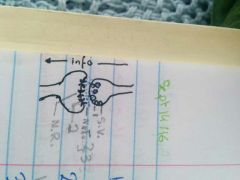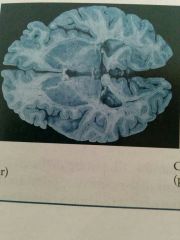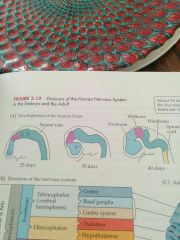![]()
![]()
![]()
Use LEFT and RIGHT arrow keys to navigate between flashcards;
Use UP and DOWN arrow keys to flip the card;
H to show hint;
A reads text to speech;
100 Cards in this Set
- Front
- Back
|
Roughly, how many neurons are in the brain? |
100 Billion (six zeroes) |
|
|
Roughly, how many synapses are in the brain? |
10^15 synapses on the brain |
|

Name the four zones: |
1. Input Zone, 2. Integration Zone, 3. Conduction Zone, 4. Output Zone |
|
|
What does the Input Zone consist of? |
Dendrites that recieve information. |
|
|
What does the Integration Zone consist of? |
The cell body or Soma that collects the information. |
|
|
What is the Axon Hillock? |
The part of the Soma (cell body) that connects with the Axon, that father's info and turns it into electric impulses. |
|
|
What does the Conduction Zone consist of? |
A single conducting nerve fibre, the Axon. |
|
|
What does the Output Zone consist of? |
Selling at the end of the axon, synaptic buttons, that transmit signals across synapses. |
|
|
Hope many main type of neurons are there? |
3 |
|
|
What Neuron is large, with long axons, and transmitted info to muscles for movement? |
Motorneurons |
|
|
What Neuron differs in size and shape, depending on what sensory information it collects? |
Sensory Neurons |
|
|
What Neuron are tiny, and communicate across various parts of the brain? |
Interneurons |
|
|
Describe a Multipolar Neuron? |
It has many dendrites, one axon, and a 'pyrimidal' shape. The most common Neuron. |
|
|
Describe a Bipolar Neuron? |
A single dendrite, and a single axon. Most common for Sensory Neurons. |
|
|
Describe Mono/Unipolar Neurons? |
1 single extension from soma: the axon, and both the input and output zones. Most common for relaying touch info from body to spine. |
|
|
What is the difference between a Presynaptic Nerve and a Postsynaptic Nerve? |
Electrical information is transmitted from the Axon Terminals of a Presynaptic Neuron TO the Postsynaptic Neuron. |
|

What are 1, 2, and 3? |
1. The Presynaptic Membrane, 2. The Postsynaptic Membrane, 3. The Synaptic Cleft |
|
|
What is the distance of the Synaptic Cleft? |
20-40 nm |
|
|
Define Neuroplasticity: |
The general term for continuous remodeling of the neurons in the brain, specificity the connections between Dendrites and Axon Terminals. |
|
|
What is the difference between Axon Transport and Axon Transmission? |
Axon Transport is inside the cell, and describes how important chemicals that are made in the cell body are transported throughout the cell. Axon Transmission is the transfer of Action Potentials alone the outer membrane. |
|
|
List the four types of Glial Cells: |
Oligodendrocytes, Schwan Cells, Astrocytes, Microglial Cells |
|
|
What is the difference between Oligodendrocytes and Schwan Cells? |
They are both glial cells that produce myelin, but the Oligodendrocytes are doing in the CNS and Schwan Cells are found in the PNS. |
|
|
What are the Nodes of Ranvier? |
They are gaps between myelination where Action Potentials jump from Neuron to Neuron. |
|
|
What is an Edema? |
When Glial Cells get injured, they swell, and cause pressure in the brain. |
|
|
Define: Nerves |
A bundle of Axons outside the CNS. |
|
|
What is the difference between Motor and Sensory Nerves? |
Motor Nerves transmit information from spine TO muscles and glands, Sensory Nerves transmit information from the receptors to the brain. |
|
|
What if the difference between Somatic and Autonomic Nervous System? |
The SNS are nerves connecting CNS to major muscles and Sensory systems (voluntary movement). The ANS are nerves connecting CNS to the viscera or the internal organs (involuntary movement). |
|
|
What are the Cranial Nerves? |
12 pairs of nerves, one on each side, that innervates the heads, neck and internal organs, without connecting to the spine. |
|
|
How many pairs of Cranial nerves do we have? |
3 pairs of sensory nerves, 5 pairs of motor nerves, and 4 pairs of both sensory and motor nerves. |
|
|
What are the Spinal Nerves? |
31 pairs of nerves, that innervates the body through the spine. The motor fibres come out the front, the sensory fibres come in the back. Each nerve has a location on the spine. |
|
|
What are the five spinal locations, or the 5 groups of Spinal Nerves? |
Cervical > Thoracic > Lumbar > Sacial > Coccygeal |
|
|
How many pairs of Spinal Nerves are in the Cervical Region? |
8 pairs, for the neck. |
|
|
How many pairs of Spinal Nerves are in the Thoracic Region? |
12 pairs, for the trunk. |
|
|
How many pairs of Spinal Nerves are in the Lumbar Region? |
5 pairs, for lower back. |
|
|
How many pairs of Spinal Nerves are in the Sacral Region? |
5 pairs, for the pelvis. |
|
|
How many pairs of Spinal Nerves are in the Coccygeal Region? |
1 pair, at the bottom. |
|
|
What is the difference between Parasympathetic and Sympathetic NS? |
The SNS consists of the middle area of the spine. It's responsible for the fight out flight response. The PSNS consists of the areas above and below the middle parts of the spine. It's responsible for the rest and digest response. |
|
|
What do the Parasympathetic and Sympathetic NS have in common with the Autonomic Nervous System? |
The PSNS and the SNS make up the ANS. |
|
|
Define: Gyrus (Gyri) |
The raised portions of the Cortex. |
|
|
Define: Sulcus (Sulci) |
The 'valleys' separating the Gyri in the cortex. |
|
|
How heavy is the brain and how much energy does it require? |
The brain if roughly 3 llbs, or 2% of body weight. It requires 20% of daily energy to function. |
|

What is this planar view? And what is the front and back called? |
The Horizontal Plane or cut horizontally, the front is called Anterior, the back is called Posterior. |
|

What is this plane and directions? |
The Sagittal Plane or cut back to front, Dorsal is the top, Ventral is the bottom. |
|

What is this planar view? What are the directions? |
The Coronal Plane or cut, side to side. The top is Dorsal, the bottom is Ventral. |
|
|
What is the Sylvian Fissure? |

A Sulcus that divides the Temporal Lobe from other regions. |
|
|
What is the Central Sulcus? |

A Sulcus that divides the Frontal and Parietal lobes. |
|
|
What is the Olfactory Bulb? |

A small bump found under the Frontal Lobe and ontop of the nasal passage. Responsible for the sense of smell. |
|
|
Define: Corpus Callosum |

The bridge between cerebral hemispheres, that allows them to communicate with eachother. |
|
|
Define: The Postcentral Gyrus |

Before the Central Sulcus, a raised part of the Parietal Cortex that recieves and mediated Touch Sensory information. |
|
|
Define: Precentral Gyrus |

Infront of the Central Sulcus, a raised portion of the Frontal Cortex that is crucial for motor control. |
|
|
Define: Tract |
A bundle of Axons in the CNS. |
|
|
What is the difference between a Tract and a Nerve? |
A Tract is a bundle of Axons in the CNS, a Nerve if a bundle of Axons in the PNS. |
|
|
Define: The Cortical Column |

The basic organization of the cortex, vertically. There are 6 layers. |
|
|
Define: The Neural Tube |
The prenatal structure that will become the brain. Has 3 parts, the fore/mid/hindbrain. |
|
|
Define: the Forebrain |

The front of the Neural Tube, it will become the cerebral hemispheres, the Thalmus and the Hypothalamus. |
|
|
Define: the Midbrain |

The middle of the Neural Tube, turns into the middle of the brain, which has Sensory and Motor Systems. |
|
|
Define: the Hindbrain |

The rear of the Neural Tube, becomes the cerebellum, pons, and medulla. |
|
|
Define: Nucleus |
A collection of neurons in the brain that super eachother in the same function. |
|
|
What are the three protective membranes around the CNS? |
1. Dura Mator - the tough outer sheet. 2. Pia Mator - Innermost sheet. 3. Arachnoid - the web like suspension between the two Mators. |
|
|
What two liquids are essential for a healthy brain? |
1. Cerebrospinal Fluid (CSF) 2. Blood |
|
|
Define: Cerebral Arteries |
The 3 pairs of arteries that connect the heart and brain directly. |
|
|
Describe: the Blood-Brain Barrier |
A barrier that makes it harder to exchange blood in the brain than anywhere else in the body. Most likely to protect brain from any toxins. |
|
|
Describe: the Frontal Lobe |
The front. motor control, cognition, language, impulse control and smell. Has the Olfactory Bulb. |
|
|
Describe: the Parietal Lobe |
In-between the front and back. Deals with Sensory information. Recieves where visual information from Occipital Lobe. |
|
|
Describe: the Temporal Lobe |
On the sides. Auditory information and memory. Understanding of language, has the Wernika Area. Also accepted what visual information from the Occipital Lobe. |
|
|
Describe: the Occipital Lobe |
The back of reach hemisphere. Recieves all Visual Stimulus before sending it out to Temporal or Parietal Lobe. |
|
|
Define: the Cerebellum |
Under the brain, important for motor co-ordination and learning. |
|
|
Define: the Pons |
Point of origin for many cranial nerves. Between midbrain and medulla. |
|
|
Define: the Medulla |
Connects with spine, in charge of 'living behaviors' like breathing and heart rate. |
|
|
Define: the Lizard Brain |
The brain stem and cerebellum. |
|
|
Why is it that the bigger an animal, the bigger the brain? |
It requires more brain size to innervate a larger body. ** Brains are disproportionality large in humans |
|
|
Describe: the Executive Brain Ratio |
This is the ratio of the size of the cerebellum divided by the size of the lizard brain. This ratio shows how 'intelligent' an animal is |
|
|
What if the difference between Caroted and Vartegral Arteries? |
They are the main supply of blood for the brain, but the Caroted bypass the spine. |
|
|
Why do the Caroted and Vartegral Arteries usually go to the same place? |
Just Incase one of them is damaged or bloked, the other can still provide blood. |
|
|
Describe: a Stroke |
The blockage or ruptures of vessels or arteries in the brain. Also called a Cerebrovascular Accident (CVA). It usually happens because a Thrombosis (blood clot) forms, and leads to Ischemera (suffocation from lack of oxygen). It's the third most common death. |
|
|
Describe: the Lateral Ventricle |

C- shaped, extends to all four lobes. |
|
|
Describe: the Third Ventricle |

Channels CSF from the Lateral Ventricle to the Fourth Ventricle. |
|
|
Describe: the Fourth Ventricle |

In the Pons, it releases CSF to surround the brain. |
|
|
What are the three uses for Cerebrospinal Fluid (CSF)? |
1. It provides nutrients to the brain. 2. It provides cushion from shocks. 3. During sleep, it cleans out toxins by filtering through expanded brain channels. |
|
|
What is the difference between Dorsal and Ventral? |
Dorsal is the top, Ventral is the bottom |
|
|
What is the difference between Anterior and Posterior? |
Anterior is the front, Posterior is the back. |
|
|
What is the difference between Medial and Lateral? |
Medial is towards the centre line, Lateral is away from the centre line. |
|
|
What is the difference between Superior and Inferior? |
Superior is above something, Inferior is below something. |
|
|
What is the distance between Rostral and Raudal? |
Rostral is Infront of something, Raudal is behind something. |
|
|
What is the difference between Proximal and Distal? |
Proximal is close to something, Distal is far away from something. |
|
|
What is the difference between Afferent and Efferent? |
Afferent projects towards something, Efferent projects away from something. |
|
|
What is the difference between Ipsilateral, Contralateral, and Decussate? |
Ipsilateral is on the same cerebral hemisphere, Contralateral is on the other cerebral hemisphere, Decussate means the structure crosses the midline separating both hemispheres. |
|
|
How many anatomical markers are in the brain? |
There are 52 markers. They organizer the brain based by structure. |
|
|
How many ways can you organize the brain? |
1. By Cortical Areas: using anatomical markers. 2. By Cellular Difference: how large the six vehicle layers of the brain are. 3. By Embryonic Divisions: the fore/mid/hindbrain. |
|
|
How much of the brain can you physically see? |
Only 1/3. |
|
|
Define: the Primary Sensory Cortex. |
Layer IV (the input later) is thicker, with more cells accepting sensory information. |
|
|
Define: the Primary Motor Cortex |
Layers V and VI (motor output layers) with more neurons sending out motor command. |
|
|
Define: the Association Cortex |
All layers are roughly equal, with cells accepting and innervating information. |
|
|
Define: Left Brained |
They are logical. The left brain deals with logic, reason, language. (Has both Wernika and Broka) |
|
|
Define: Right Brained |
They are artistic. The right brain is responsible for space manipulation, music, emotion, and facial recognition. |
|
|
Define: Contralaterality |
The right side of the world is processed by the left side of the brain and vice versa. |
|
|
Define: Telencephalon |

The part of the Forebrain in the Neutral Tube, that will become the future Cerebral Hemispheres. |
|
|
Define: Diencephalon |

Part of the Forebrain in the Neural Tube, that becomes the future Thalmus, Hypothalamus, and Pituitary Gland. |
|
|
Describe: the Thalmus |
- 10% is dedicated to collecting and distributing all Sensory information to the rest of the brain - 20% is dedicated to filtering out unnecessary stimulus. |
|
|
Describe: the Hypothalamus |
Controls the endocrine system through the Pituitary Gland. |

